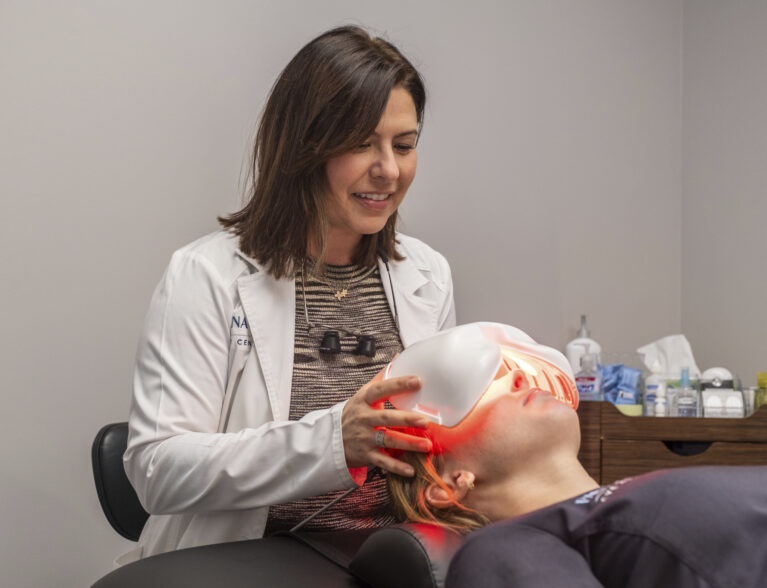
Millions of people worldwide suffer from dry eye disease (DED), which can cause discomfort, vision disturbances and a decline in quality of life. Traditional treatments such as artificial tears, anti-inflammatory medications and lifestyle changes often help but may not fully address the underlying causes of this multifactorial condition.
“Some of the symptoms of dry eye disease include a stinging, burning or itching of your eyes, sensitivity to light, blurred vision and eye fatigue,” said Dr. Sarah Khodadadeh, a board-certified ophthalmologist and owner of Panacea Eye Center in Vero Beach. “You might have difficulty with nighttime driving or wearing contact lenses and your eyes are constantly watering, which is the body’s natural response to the dry eye irritation.”
Dry eye disease occurs when your tears don’t provide adequate lubrication for your eyes. You may not produce enough tears, or you may be producing inferior quality tears. This tear deficit leads to inflammation and damage to the eye’s surface.
In recent years, a type of light therapy has emerged as a promising innovation for treating dry eye, especially for those with meibomian gland dysfunction (MGD), a leading contributor to dry eyes. MGD involves blockage or dysfunction of the meibomian glands, which produce the lipid layer of tear film that prevents rapid evaporation.
“The front oil layer on your tears is made by the meibomian glands,” Dr. Khodadadeh explained. “If an oil gland gets plugged up, or you have a meibomian gland dysfunction, you don’t have a nice blanket of oil on the front of the tears and the tears evaporate.
“You also have a water layer, which is the biggest layer. It’s called the aqueous layer and it’s made by your lacrimal gland. It’s located in the upper outer eye socket and flows across the surface of the eye and drains into two tiny holes called the puncta that go into the nose. That’s why when you cry, your nose runs. As people age, they don’t make as many aqueous tears and their body starts to create an inflammatory cycle of cytokines. Cytokines signal cells to fight off threats like viruses and bacteria. In order to get yourself out of that cycle, you have to decrease the inflammation.”
Until recently, dry eye disease was treated with topical eyedrops and artificial tears but now a combination of Intense Pulsed Light and Low Level Light Therapy has proven beneficial in helping patients make their own tears while decreasing inflammation at the same time.
Intense Pulsed Light (IPL) uses bursts of broad-spectrum light to heat the eyelids and skin around the eye, reducing inflammation by decreasing pro-inflammatory cytokines. The treatment also targets and eliminates abnormal blood vessels that contribute to inflammation, and liquefies and unclogs the meibomian glands, improving the stability of the tear film.
Low Level Light Therapy (LLLT) utilizes LED-based light in the near infrared spectrum to stimulate cellular repair and improve glandular function. This enhances circulation and promotes natural healing.
Unlike artificial tears, which offer temporary relief, light therapy addresses the root cause of MGD, resulting in sustained improvements in tear quality and patient comfort.
“Before I recommend light therapy for anyone, I give them a thorough eye exam so that I can determine how severe their condition is and what the intensity of their treatment should be,” Dr. Khodadadeh continued. “I check both eyes with a meibographer to determine the function of their meibomian glands. Then I use a Demodex camera to see if they have any little crusting at the edges of the eye, and it’s followed by a topography so that I can see if there’s any punctate staining from dryness. I take all that information and do a Fitzpatrick scale test to see what level the patient is at and devise a treatment plan.”
The light therapy procedure is as relaxing as going to a spa for a massage. You lie comfortably on a massage table while listening to your favorite music. For IPL you wear a protective shield over your eyes as the technician administers a series of quick light flashes around the eyes. Next, the protective shield is removed and a lightweight, low-level light therapy mask with rows of imbedded LED lights is placed over your face.
All you have to do is relax, close your eyes and enjoy the multicolored light show that permeates even through closed eyelids. During your treatment you will receive a series of red, yellow and blue light pulses, each with its own benefits. You will experience warmth around the area and a flash of light lasting a small fraction of a second. LLLT works at the biological level, generating endogenous heat through powerful LEDs stimulating ATC production in cells.
“The treatment lasts just 15 minutes and most of my patients tell me that they feel relaxed, and their eyes feel smooth,” Dr. Khodadadeh said. “After the treatment we apply a 30SPF sunscreen and ask you to limit your sun exposure for 24 to 42 hours. The number of treatments you need will depend upon the severity of your dry eye disease.”
Light therapy has revolutionized the treatment for dry eye disease by addressing the underlying causes rather than just alleviating the symptoms. Its ability to improve meibomian gland function, reduce inflammation, and provide long lasting relief has made it a mainstay treatment.
Dr. Sarah Khodadadeh obtained her MD from Wayne State University, where she fell in love with ophthalmology while on rotation as a medical student. She completed her glaucoma fellowship at Yale University. She is accepting new patients at her private practice, Panacea Eye Center, 1000 37th Place, Suite 101 in Vero Beach. Call 772-758-1000 to schedule an appointment.



